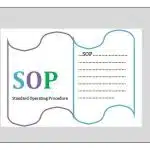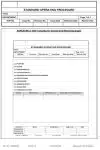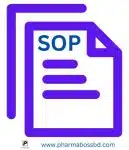Learn how to write SOP for Storage and Use of CRS (Chemical Reference Standard) in Quality Control Laboratory at Pharmaceutical Plant.
Table of Contents
1.0 PURPOSE
To describe the procedure for storage and use of CRS in the QC Laboratory.
2.0 SCOPE
The scope of this SOP includes all Chemical Reference Standards in the Quality Control Laboratory at the Pharmaceutical Plant.
3.0 RESPONSIBILITIES
3.1 Executive, QC is responsible for the storage and use of CRS.
3.2 Sr. Executive/Manager, QC is responsible for checking the activities of storage and use of CRS.
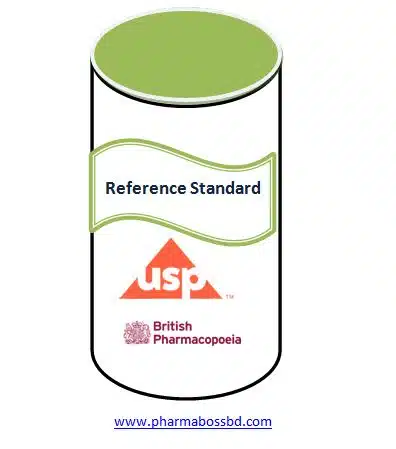
4.0 ACCOUNTABILITY
Head of Department, Quality Assurance (QA)
5.0 ASSOCIATED DOCUMENT
Nil
6.0 PRECAUTION
Wear a protective apron, spectacles, gloves, mask, etc. during work if necessary.
7.0 PROCEDURE
7.1 Storage
7.1.1 Receive chemical reference standards from appropriate sources.
7.1.2 Maintain a log book for CRS.
7.1.3 Logbook containing the following information:
Name of the CRS, receiving date, receive quantity, origin, issued quantity, balance quantity, used by & date, storage condition, potency if available, and remarks.
7.1.4 Store the chemical reference standard securely so as to avoid cross-contamination.
7.1.5 Keep the CRS in a desiccator containing activated silica.
7.1.6 Keep the MSDS of reference standard if available.
7.1.7 Preserve the documents and analytical information at least for 5 years after the use of the reference standard.
7.1.8 Keep the CRS in the refrigerator whose storing temperature is 2-8°C.
7.2 Use
7.2.1 Take the CRS from the desiccators /refrigerator and check the expiry date if available.
7.2.2 Keep it a few minutes to attain room temperature if necessary.
7.2.3 Weigh accurately with minimum exposure to air.
7.2.4 Close the container tightly and wrap the cap with Para film & keep it in the right place.
8.0 DEFINITIONS
8.1 Chemical Reference Standard (CRS): Chemical substance whose potencies are known and used as a reference sample in UV, IR, and chromatographic procedures.
8.2 MSDS: MSDS stands for Material Safety Data Sheet. It’s a document that provides information about the potential hazards, handling, storage, and emergency procedures related to a chemical substance or product. It’s crucial to ensure the safe use and handling of chemicals in various industries to prevent accidents and protect human health.
8.3 CRS: A chemical reference standard is a well-characterized substance used as a benchmark for analytical and quality control purposes in laboratories. It ensures accuracy and consistency in measurements and comparisons across different experiments and instruments
Read Also: SOP for Qualification of Working Standard
9.0 ABBREVIATIONS
9.1 QA- Quality Assurance
9.2 QC – Quality Control
9.3 CRS- Chemical Reference Standard
9.4 MSDS – Material Safety Data Sheets
9.5 SOP – Standard Operating Procedure
9.6 IR- Infrared
9.7 UV – Ultra Violate (UV -Spectrophotometer)
10.0 ANNEXURES
10.1 Annexure-1: Stock Control of Chemical Reference Standard (CRS)
Frequently Asked Questions (FAQs)
What is a reference standard?
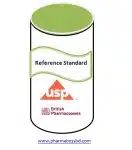
A reference standard is a recognized and established measurement, material, or procedure used as a benchmark for comparison and quality control in various fields, ensuring accuracy and consistency.
Why are reference standards important?
Reference standards provide a consistent basis for measurement and evaluation, allowing accurate comparisons between different instruments, methods, or materials. They ensure reliability and traceability in industries like pharmaceuticals, manufacturing, and sciences.
How are reference standards used in testing?
Reference standards are used as calibration tools to validate and calibrate instruments and testing methods. By comparing the measurements obtained from the instrument with the known values of the reference standard, accuracy and reliability can be verified.
What is traceability in reference standards?
Traceability refers to the documented path that establishes a connection between a measurement result and a reference standard through a series of comparisons, ensuring the reliability and accuracy of the measurement.
What is MSDS?
MSDS stands for Material Safety Data Sheet. It’s a document that provides information about the potential hazards, handling, storage, and emergency procedures related to a chemical substance or product. It’s crucial to ensure the safe use and handling of chemicals in various industries to prevent accidents and protect human health.

Abdus Sobhan Salim is professional experienced pharmacist in pharmaceuticals, author and founder of pharmabossbd.com, the first Bangladeshi pharmaceutical blogger since 2019.

